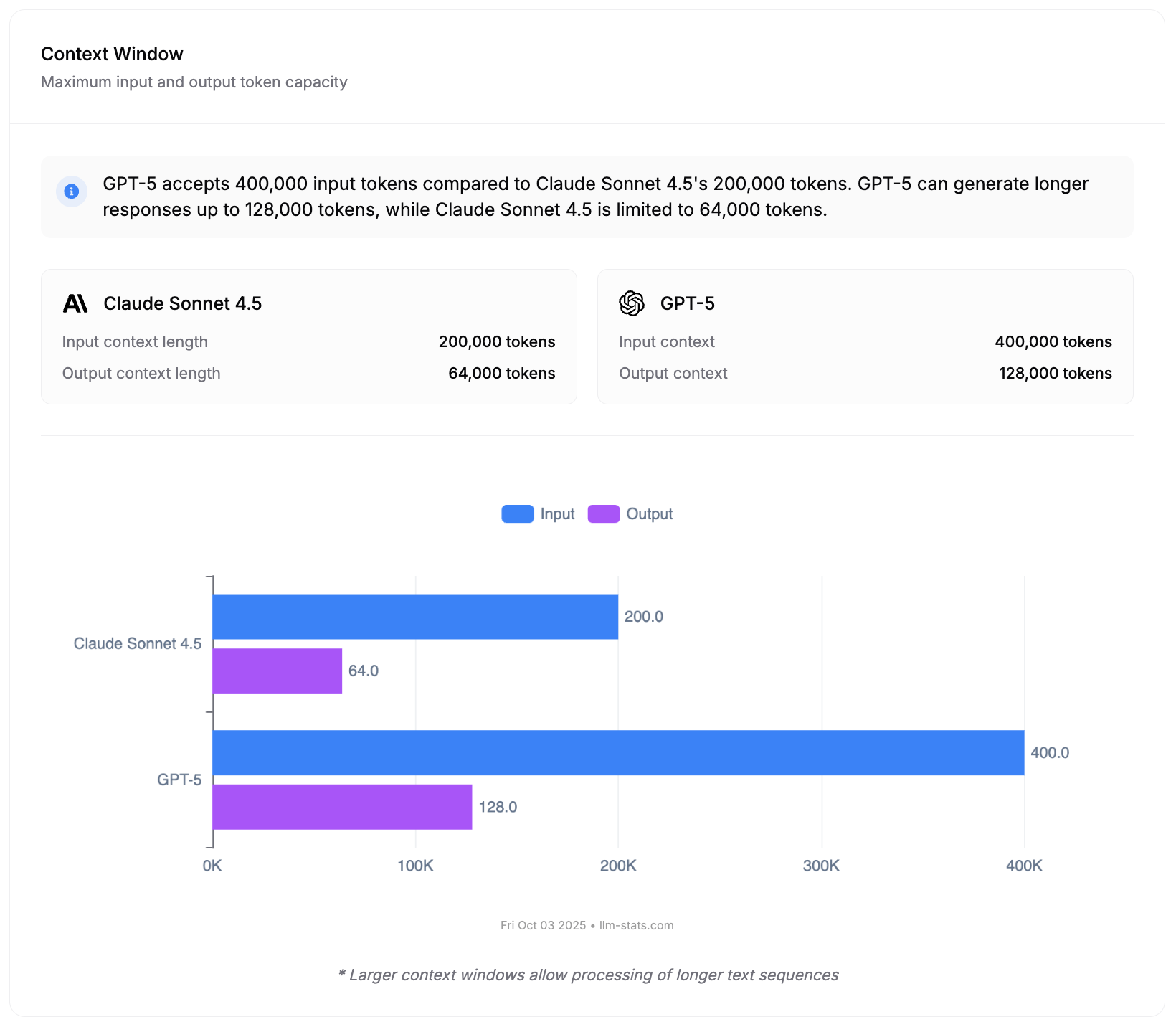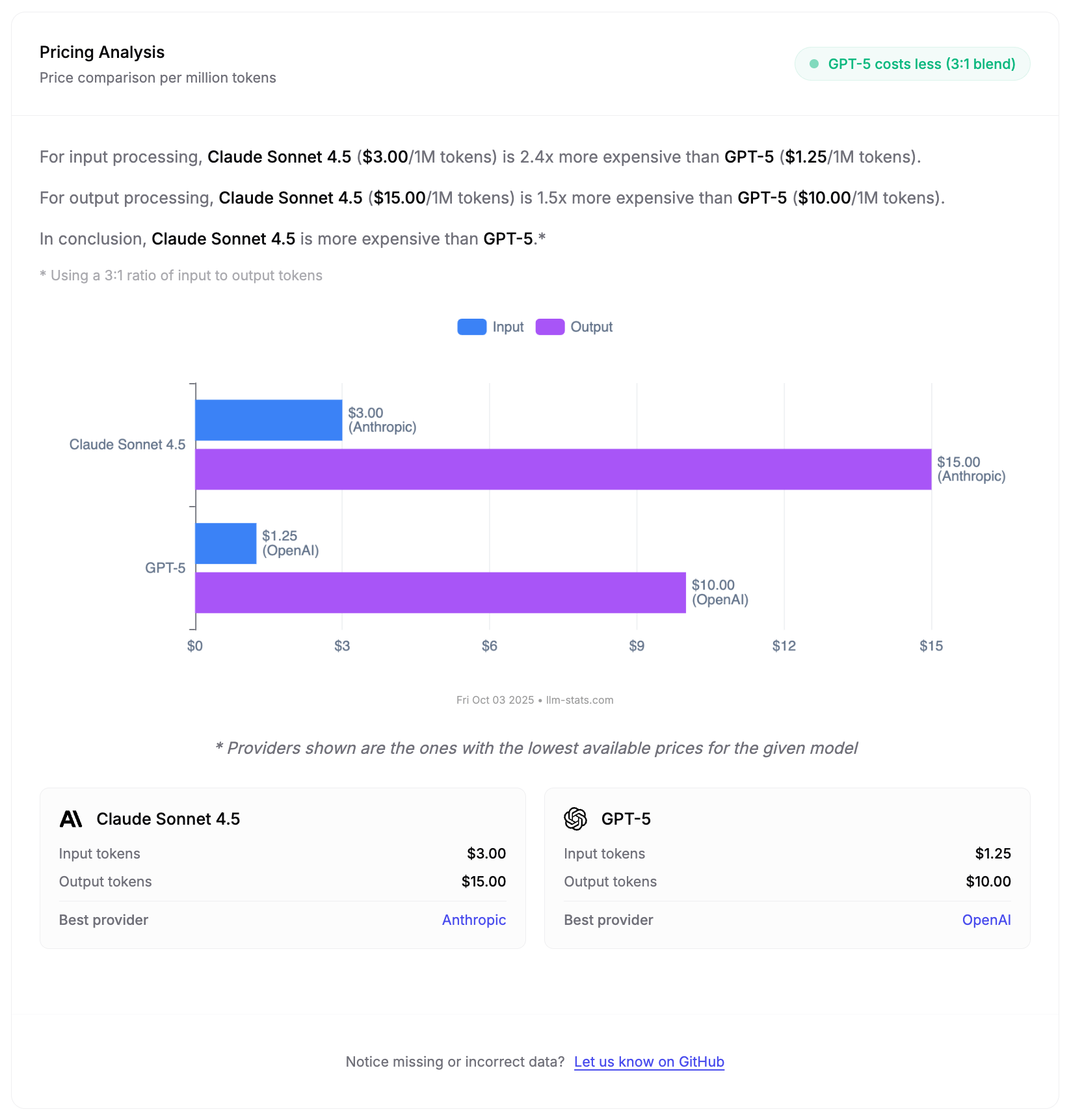
Claude Sonnet 4.5 vs GPT-5: Complete AI Model Comparison 2025
Compare Claude Sonnet 4.5 and GPT-5 across performance, safety, and applications. Discover which AI model best fits your needs in our detailed analysis.

The AI landscape has reached a pivotal moment with two groundbreaking models competing for dominance: Anthropic's Claude Sonnet 4.5 and OpenAI's GPT-5. Both represent significant leaps forward in artificial intelligence capabilities, yet they take distinctly different approaches to solving complex problems.
With GPT-5 launching in August 2025 and Claude Sonnet 4.5 following in September 2025, both flagship models are now available for direct comparison. Understanding their key differences, from reasoning architectures to safety protocols, will help you choose the right model for your specific needs.
This comprehensive comparison examines how these AI powerhouses stack up across performance benchmarks, safety measures, and real-world applications. Whether you're a developer, researcher, or enterprise decision-maker, this analysis will guide you through the strengths and limitations of each model.
Claude Sonnet 4.5: Hybrid Reasoning Explained for AI Users
Claude Sonnet 4.5 introduces a revolutionary hybrid reasoning architecture that sets it apart from traditional AI models. This system allows users to toggle between two distinct modes: a fast, low-latency default mode for routine tasks and an extended reasoning mode for complex problem-solving.
The hybrid approach addresses a critical challenge in AI deployment: balancing speed with depth. Simple queries receive instant responses, while complex scenarios automatically trigger deeper analysis. This flexibility makes Claude Sonnet 4.5 particularly effective for dynamic environments where both quick answers and thorough reasoning are essential.
Anthropic deployed Claude Sonnet 4.5 under AI Safety Level 3 (ASL-3) protections after extensive testing across cybersecurity, CBRN risk, and multi-turn misuse scenarios. The model achieves an impressive 99.29% harmless response rate, demonstrating robust safety measures without compromising functionality.
With a context window of up to 200k tokens and automatic summarization beyond 180,000 tokens, Claude Sonnet 4.5 excels at processing extensive documents and maintaining coherent conversations across lengthy interactions.
To read more about Claude Sonnet 4.5, check out our complete analysis.
GPT-5: Unified Intelligence for Advanced Applications
GPT-5 takes a different architectural approach with its unified system design. Rather than user-controlled mode switching, GPT-5 employs a real-time router that intelligently selects between a fast model for standard queries and a deeper reasoning model for complex problems.
This router continuously learns from real signals, including user behavior patterns, preference rates, and measured correctness. The system analyzes conversation type, complexity, tool requirements, and explicit user intent to determine the optimal model for each interaction.
GPT-5's development on three core areas where ChatGPT sees the most usage: writing, coding, and health applications. The model features safe-completions technology, which maximizes helpfulness while adhering to strict safety constraints.
GPT-5 offers a substantial 400k token context window, doubling Claude Sonnet 4.5's capacity. This expanded context enables more comprehensive document analysis and extended conversational memory.
Performance Benchmarks: Claude Sonnet 4.5 vs GPT-5

View full Claude Sonnet 4.5 vs GPT-5 comparison →
The performance comparison reveals distinct strengths for each model. Claude Sonnet 4.5 dominates in agentic coding and tool use scenarios, outperforming all competing models in these specialized areas. Its hybrid reasoning architecture proves particularly effective for tasks requiring both rapid iteration and deep problem-solving.
GPT-5 demonstrates superior performance in writing, coding, and health applications. In healthcare specifically, GPT-5's reasoning model achieves a remarkable improvement on HealthBench Hard, jumping from 31.6% (previous best) to 46.2%. This represents a substantial advancement in medical AI capabilities.
Both models excel in mathematical reasoning, with GPT-5 scoring 0.85 on MATH benchmarks and achieving 0.93 on HMMU evaluations. Claude Sonnet 4.5's performance in these areas remains competitive, though specific numerical comparisons aren't directly available.
Programming capabilities show interesting differences. GPT-5 scores 0.93 on HumanEval and 0.75 on SWE-Bench Verified, indicating strong coding proficiency. Claude Sonnet 4.5's strength in agentic coding suggests it may excel more in autonomous programming tasks rather than traditional coding evaluations.
AI Safety Measures: Comparing Claude Sonnet 4.5 and GPT-5
Safety implementations differ significantly between the models. Claude Sonnet 4.5 operates under Anthropic's rigorous ASL-3 framework, which includes comprehensive testing across multiple risk categories. The 99.29% harmless response rate reflects this thorough approach to safety training.
GPT-5 employs a multi-layered safety system centered on safe-completions training. This approach focuses on output safety rather than binary intent classification, allowing for more nuanced responses to potentially sensitive queries. The system includes real-time automated oversight that monitors and blocks unsafe prompts and generations.
OpenAI has implemented a two-tiered protection system for GPT-5, with account-level enforcement that scans conversations for potential violations using both automated systems and human review. For specialized applications like life sciences research, GPT-5 offers a Special Access Program for vetted customers.
Both models demonstrate strong performance in safety evaluations, though their approaches reflect different philosophies. Claude Sonnet 4.5 emphasizes prevention through robust training and testing, while GPT-5 focuses on dynamic content filtering and contextual safety decisions.
Applications and Use Cases: Claude Sonnet 4.5 vs GPT-5
Enterprise applications highlight the models' different strengths. Claude Sonnet 4.5 excels in scenarios requiring secure automation, research agents, and enterprise copilots. Its 200k token context window proves valuable for knowledge retrieval, customer support automation, and secure data processing.
The hybrid reasoning architecture makes Claude Sonnet 4.5 particularly suitable for environments where users need both quick responses and deep analysis capabilities. Enterprise copilots can switch between modes based on query complexity, optimizing both user experience and computational resources.
GPT-5's unified system with intelligent routing suits applications requiring seamless performance scaling. The model's strengths in writing, coding, and health make it ideal for content creation platforms, software development environments, and medical assistance applications.
Healthcare applications represent a significant opportunity for GPT-5, given its substantial performance improvements in medical reasoning. The 400k token context window enables comprehensive patient record analysis and complex medical literature review.
Key Considerations: Choosing Between Claude Sonnet 4.5 and GPT-5
Context requirements play a crucial role in model selection. GPT-5's 400,000-token capacity provides significant advantages for applications processing extensive documents or maintaining long conversational threads. Claude Sonnet 4.5's 200k token limit may require document chunking strategies for very large inputs.

View full Claude Sonnet 4.5 vs GPT-5 comparison →
Safety requirements vary by use case. Organizations handling sensitive data might prefer Claude Sonnet 4.5's ASL-3 framework and demonstrated harmless response rate. Applications requiring dynamic content filtering might benefit from GPT-5's safe-completions approach.
Performance priorities should align with model strengths. Choose Claude Sonnet 4.5 for agentic coding, tool use, and scenarios requiring user-controlled reasoning modes. Select GPT-5 for writing assistance, traditional coding tasks, and healthcare applications.
Both models are now available for deployment. GPT-5 launched in August 2025, followed by Claude Sonnet 4.5 in September 2025, giving organizations immediate access to both options for evaluation and implementation.
Pricing Comparison: Claude Sonnet 4.5 vs GPT-5
The pricing difference between these models is substantial. GPT-5 costs $1.25 per million input tokens and $10.00 per million output tokens, making it 2.4x cheaper for input and 1.5x cheaper for output compared to Claude Sonnet 4.5 at $3.00 and $15.00 respectively.

View detailed pricing breakdown →
This advantage is particularly significant for high-volume applications like API integrations, customer support automation, and content generation platforms. However, Claude Sonnet 4.5 may justify its premium through superior agentic coding performance and enhanced safety frameworks—consider total cost of ownership beyond raw token pricing.
The Future of AI: Claude Sonnet 4.5 vs GPT-5 Architectures
These models represent two compelling visions for AI development. Claude Sonnet 4.5's hybrid approach empowers users with direct control over reasoning depth, potentially leading to more efficient resource utilization and transparent AI interactions.
GPT-5's unified system with intelligent routing promises seamless user experiences where optimal model selection happens automatically. This approach may prove more intuitive for general users while maintaining sophisticated capabilities behind the scenes.
Both architectures offer compelling advantages, and their success will likely depend on specific use cases and user preferences. The competition between these approaches will drive continued innovation in AI system design.

View detailed pricing breakdown →
Claude Sonnet 4.5 and GPT-5 represent the current pinnacle of AI development, each offering unique strengths suited to different applications. Claude Sonnet 4.5 leads in agentic tasks, safety frameworks, and user-controlled reasoning, while GPT-5 excels in writing, healthcare applications, and seamless intelligence routing. Your choice between them should align with your specific performance requirements, safety needs, and implementation timeline. As both models continue evolving, they'll likely inspire new approaches to AI architecture that combine the best elements of hybrid and unified systems.
For a full breakdown of performance and pricing, check out our complete comparison.